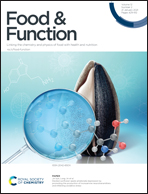Identification of novel dipeptidyl peptidase IV and α-glucosidase inhibitory peptides from Tenebrio molitor†
Abstract
The exponential increase in world population is leading to a need for new sustainable protein sources that could supply the high demands without resulting in an enormous environmental impact. Bioactive peptides from food proteins are currently seen as capable of modulating physiological processes, such as diabetes. The potential of insects as a cheap source of antidiabetic peptides is a recent research topic. In this work, fractionation and identification of dipeptidyl peptidase IV (DPP-IV) and α-glucosidase inhibitory peptides from mealworm (Tenebrio molitor) was carried out. Peptides from 500 to 1600 Da showed the highest level of DPP-IV inhibition (IC50 value of 0.91 mg ml−1) and peptides below 500 Da showed the highest level of α-glucosidase inhibition (IC50 value of 2.58 mg ml−1). Numerous novel peptides were identified from the most bioactive fractions, and based on the molecular features usually described for these peptides, some of them are suggested to be the bioactive peptides responsible for the inhibition observed (e.g. APVAH for DPP-IV inhibition and CSR for α-glucosidase inhibition). Hence, these insect protein hydrolysates or their purified fractions could be used as ingredients for regulation of the glycaemic index.



 Please wait while we load your content...
Please wait while we load your content...